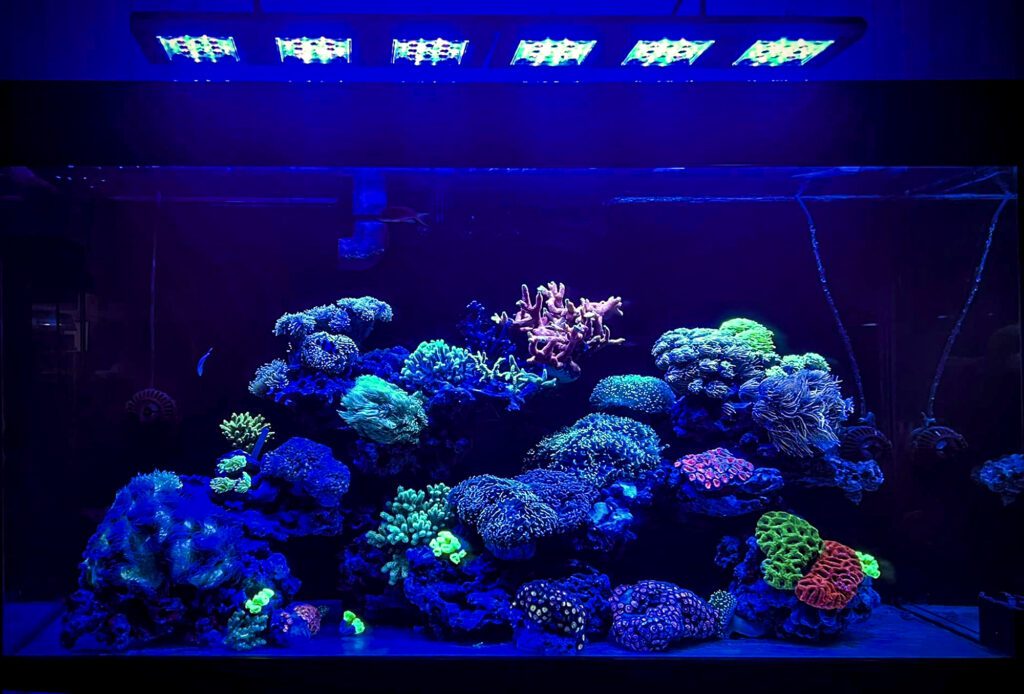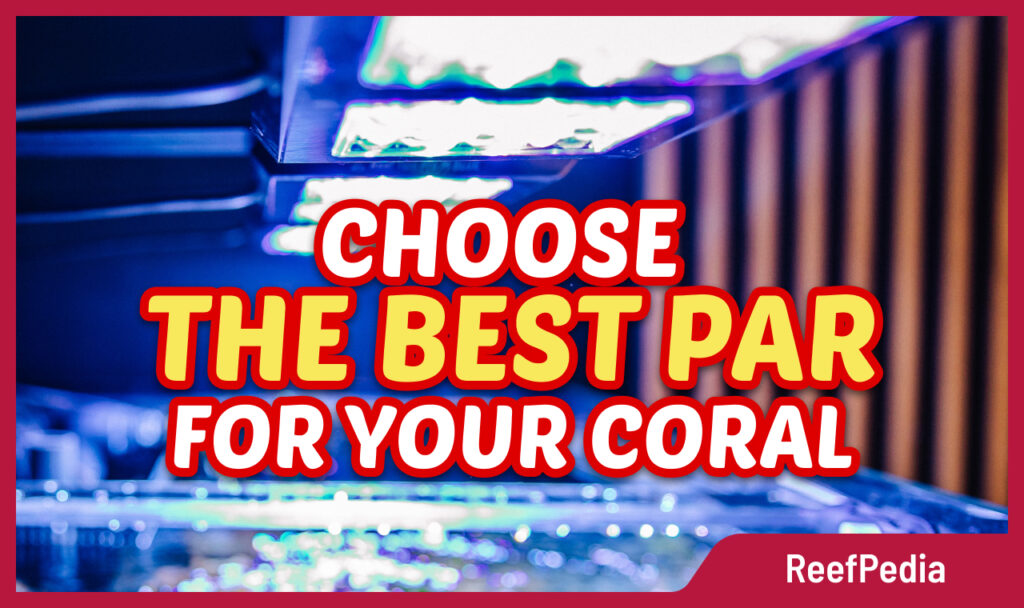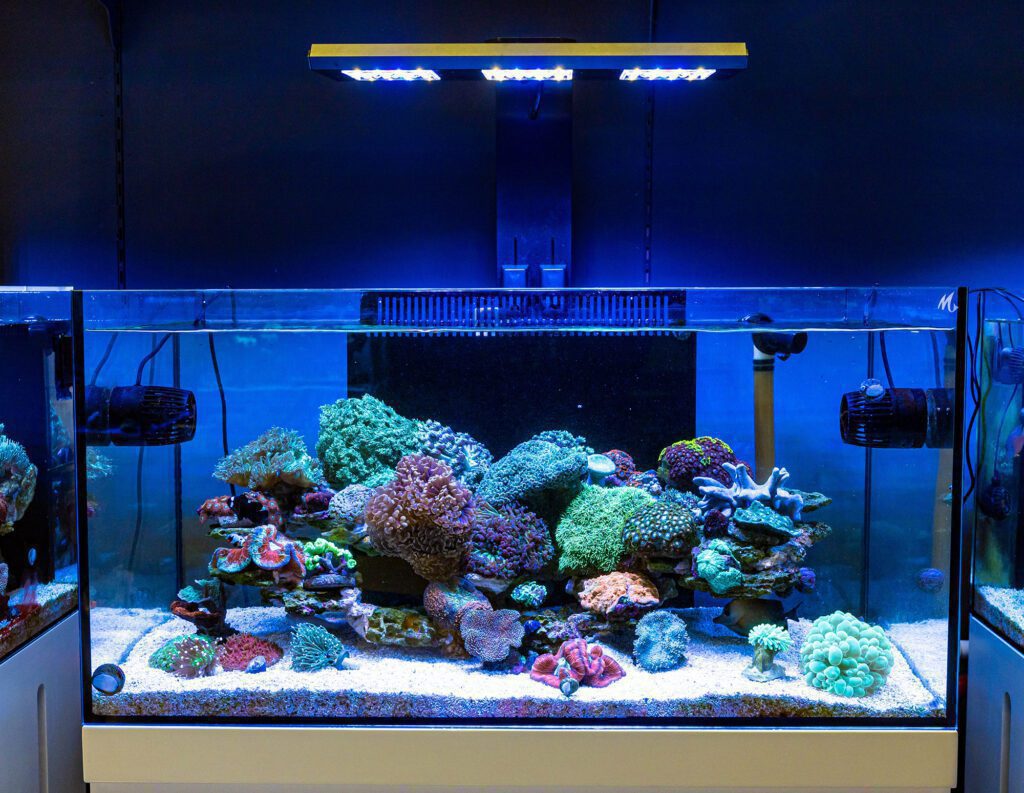Licht in einem Meerwasseraquarium - das musst du wissen!
I am writing this article because there is a constant discussion on the Internet about light in a marine aquarium. In my opinion, and I hope you will agree with me, dear reader, the subject deserves a deeper analysis. I will provide you not only with specific data on light, but also a handful of fun facts and tips.
I hope that after reading this article and those referenced in the text, you will be able to choose the right light for your aquarium.
Hope you enjoy the read!
What is light?
Let’s start with the basics. Light is an electromagnetic wave that is visible to the human eye. Light travels in a vacuum at 299,792,458 m/s and consists of electromagnetic waves of different lengths, which is why we see different colors.
Wavelengths of light
The wavelength of light is the distance between two consecutive points on an electromagnetic wave that are in the same state of vibration. In other words, it is the distance between two points on the wave that are in the same phase.
Wavelength is most commonly expressed in meters, but other units such as nanometers (nm) and micrometers (µm) are also used. The wavelength of light is one of the basic parameters that determine the properties of light, such as color, energy or frequency.
The wavelength is closely related to its frequency, which is described by the law of the relationship between wavelength and frequency – the shorter the wavelength, the higher the frequency, and vice versa. Mathematically, this can be written as:
wavelength = speed of light / frequency
where the speed of light is approximately 299,792,458 m/s in a vacuum.
Light wave ranges:
Red: about 700-635nm
Orange: about 635-590 nm
Yellow: about 590-560 nm
Green: about 560-495 nm
Blue: about 495-450nm
Violet: about 450-400 nm
UV-A: 400-315nm
PAR parameter as an indicator of lighting power
The PAR parameter (Photosynthetically Active Radiation), which we should pay special attention to, allows us to read photosynthetic active radiation. Its unit is expressed in micromoles of photons per square meter per second, and photons in the range of wavelengths stimulating the photosynthesis process (~400-700 nm) are the most valuable.
By measuring PAR, we are actually measuring the flux of photons, representing all the colors of visible light, on a specific surface. The higher the PAR value, the more intense the photon flux is, and thus the greater the number of photons incident on the surface per second. This means that the higher the PAR value, the more intensive photosynthesis is carried out.
How does light affect corals?
Corals are able to feed on light thanks to photosynthesis in their symbiotic zooxanthellae algae. These algae use light for photosynthesis, which converts carbon dioxide and water into organic compounds such as sugars and amino acids. Corals provide algae with shelter and nutrients, and in return the algae provide them with energy, oxygen and many valuable compounds.
Effect of wavelength data on coral photosynthesis
As we know, the corals we keep in our tanks most often contain symbiotic zooxanthellae algae that use light for photosynthesis. Photosynthesis is a biochemical process that converts light energy into chemical energy. Through this process, corals receive a lot of chemical energy from their zooxanthellae, in the form of sugars, fats, amino acids and oxygen.
We know that all colors stimulate photosynthesis in zooxanthellae corals. It is also known that photosynthesis is the main driver of coral growth, as it provides the corals with a lot of energy in the form of organic compounds. For many years, scientific research has been carried out on what wavelength of light is most effective for corals.
Kinzie (1984, 1987) discovered that the wavelength of light has a significant effect on photosynthesis in corals. Studies have shown that the wavelength of light affects the efficiency of photosynthesis and the development of corals. It turned out that corals „assimilate“ the best light with wavelengths of 450-550 nm (blue and green light range), and the least effective in photosynthesis are wavelengths above 600 nm (red and yellow). Blue light alone has been found to support the growth of corals and zooxanthellae as well as full spectrum white light, provided the same amount of light is used, i.e. equal PAR.
Szabo et al. (2016) conducted research on the effects of different wavelengths of light on coral growth and development. Studies have shown that light with a wavelength of 455 nm is the most effective in stimulating photosynthesis in corals.
Wangpraseurt et al. (2012) studied the effect of different wavelengths of light on photosynthetic processes in aquarium corals. Studies have shown that light with a wavelength of 455-465 nm is best absorbed by chlorophylls in corals and stimulates photosynthesis.
The observations and research we conducted at Crazy Coral on light confirm this. We obtained very good results under the full spectrum and under the blue light spectrum.
Why do corals have better blue color sensitivity?
The presence of blue light-sensitive proteins known as cryptochromes may explain this stimulating effect of blue light. Kinzie and colleagues (1984, 1987) discovered that cryptochromes are present on the surface of corals and can act as light sensors, affecting various metabolic processes such as photosynthesis. Other studies, such as those by Wangpraseurt et al. (2012), also suggest that blue light with a wavelength of 455-465 nm is best absorbed by chlorophylls in corals and stimulates photosynthesis.

Photosynthesis rate vs light intensity (growth vs light power)
Scientific studies have shown that light intensity, or irradiance, has a large effect on coral growth. Light intensity that is too low can cause coral growth to be stunted or even die, and light intensity that is too high (especially without corals and their symbiotic algae acclimating to stronger light) can cause damage to coral tissues.
The appropriate light intensity for different coral species can vary depending on their specific requirements. Find some examples from research studies below.
Studies conducted on the species Acropora muricata have shown that the optimal light intensity is about 400-500 micromol square per second (μmol m^-2 s^-1)
For the species Pocillopora damicornis, the optimal light intensity is around 200-300 μmol m^-2 s^-1 (Anthony et al., 2008).
For Stylophora pistillata, the optimum light intensity is around 300-400 μmol m^-2 s^-1 (Riddle et al., 2018).
Other studies have shown that some species of soft corals, such as Lobophytum spp. and Sinularia spp., prefer lower light intensities, around 50-150 μmol m^-2 s^-1 (Nir et al., 2014).
 TIP: So it can be assumed that PAR 50-150 μmol m^-2 s^-1 is enough for soft corals LPS and SPS corals – PAR 200-500 μmol m^-2 s^-1. Great light demanding corals and some Acropora corals – PAR 500-700 μmol m^-2 s^-1, of which higher ranges can cause stress for corals, so ensure high water circulation. The conclusions of the study indicate that the light intensity for each coral should be adjusted individually. Some corals prefer lower intensity, others, especially such as the Acropora species – higher. When changing to stronger lighting, the light power should be gradually increased (the change in light power should be slow, over a minimum of two weeks).
TIP: So it can be assumed that PAR 50-150 μmol m^-2 s^-1 is enough for soft corals LPS and SPS corals – PAR 200-500 μmol m^-2 s^-1. Great light demanding corals and some Acropora corals – PAR 500-700 μmol m^-2 s^-1, of which higher ranges can cause stress for corals, so ensure high water circulation. The conclusions of the study indicate that the light intensity for each coral should be adjusted individually. Some corals prefer lower intensity, others, especially such as the Acropora species – higher. When changing to stronger lighting, the light power should be gradually increased (the change in light power should be slow, over a minimum of two weeks).
Coloration of corals and light intensity
Research by Salih et al. (2000) confirms that high light intensity stimulates the production of fluorescent proteins and chromoproteins in corals, and that blue light is particularly effective in this process. Acropora corals require a higher PAR of up to 700 µmol m–2 s–1 or higher.
More on how to choose the right PAR for corals:


Choose the Best PAR for Your Coral
Choose the Best PAR for Your Coral
An interesting article on how to choose the right PAR for corals.
In corals, the production of green and red fluorescent proteins and non-fluorescent chromoproteins is dependent on high light intensity. For example, to achieve light pigmentation, Seriatopora hystrix, Acropora pulchra and Acropora millepora requires a PAR level of at least 700 µmol m–2 s–1 (Roth and Deheyn 2013). Studies have shown that blue light triggers this colored pigment production, and it is not directly related to photosynthesis (Salih et al. 2000).
While these bright colors are coveted by aquarists, it’s important to realize that colorful corals actually exhibit a stress response and protect themselves from excess light. Exposure to too much light leads to a reduction in zooxanthellae.





Find out more about what corals need here: Coral Growth – All You Need to Know. Remember to choose the light power wisely and gradually increase the light power. If you want to increase the light power, take care of strong water circulation.
Want to shine brighter? Ensure strong water circulation
Research conducted by Wangpraseurt and his team in 2017 suggests that strong water movement can relieve physiological stress in corals, which can have a positive effect on their health and growth. This is also important when we provide them with more light and want our corals to grow faster and be beautifully colored. The experiment used different levels of water flow in coral aquariums and studied the effects on photosynthetic activity, biomass and mucus production in corals. Studies have shown that strong water flow significantly increased coral photosynthetic activity and growth, while reducing oxidative stress, suggesting that strong water movement may be an effective method of stress relief and faster growth for corals in marine aquariums.
Research conducted by Wangpraseurt and his team in 2017 suggests that strong water movement can relieve physiological stress in corals, which can have a positive effect on their health and growth. This is also important when we provide them with more light and want our corals to grow faster and be beautifully colored. The experiment used different levels of water flow in coral aquariums and studied the effects on photosynthetic activity, biomass and mucus production in corals. Studies have shown that strong water flow significantly increased coral photosynthetic activity and growth, while reducing oxidative stress, suggesting that strong water movement may be an effective method of stress relief and faster growth for corals in marine aquariums.





How long to shine for?
In order to adequately address this topic, it is necessary to first write about the situation on coral reefs. As for coral reefs in the tropics, the sun shines on them for about 12 hours during the day, usually from 6 am to 6 pm. However, the exact time of day-to-night change and the length of day and night depends on the season and the geographic location of the reef.
It is also important to note that there are times when coral reefs are also overshadowed by clouds or weather troubles, which can reduce the amount of time the sun shines on them during the day.
In the aquarium, the recommended lighting time is 8-12 hours a day. We must remember that if we extend the lighting time, the coral gets more energy for its symbiotic algae. It seems logical that if we have a weaker light, we should shine longer. But what if we want to shine longer and have a stronger light? It is worth setting sunrises and sunsets in such a way that they provide less energy. From practice, I will write that with longer lighting and appropriate lighting power, some corals can shed part of the zooxanthellae and become slightly brighter. In some cases, this is a desirable process, such as when staining Acropora corals.





Summary
In the article, I showed that the right spectrum of light combined with the right intensity expressed in PAR units is crucial for photosynthesis by corals. On the one hand, high-quality lighting, on the other hand, acclimatization to newly purchased powerful lights are the key to success for optimal coral growth. When setting the light in the aquarium, it is very important to choose the right light power for the coral. If we care about good coral growth, it is worth setting up good water circulation. We must not forget to observe the corals. They are living animals that need time to adapt to good lighting. If we take care of these key elements, corals will repay us with fast growth and beautiful colors.
Literatura:
Szabó, M., Vidal-Dupiol, J., Moya, A., & Tambutte, E. (2016). Effect of light and temperature on the uptake of algal symbionts by coral juveniles. PloS one, 11(1), e0146961.
Kinzie, R. A. (1987). The effect of light quality on the physiology of the reef coral Montipora verrucosa. Marine Biology, 94(1), 95-109.
Kinzie III RA, Jokiel PL, York R (1984). Effects of light of altered spectral composition on coral zooxanthellae associations and on zooxanthellae in vitro
Wangpraseurt, D., Larkum, A. W. D., Ralph, P. J., & Kühl, M. (2012). Light gradients and optical microniches in coral tissues. Frontiers in Microbiology, 3, 316.
Anthony, K. R. N., D. I. Kline, G. Diaz-Pulido, S. Dove, and O. Hoegh-Guldberg. 2008. Ocean acidification causes bleaching and productivity loss in coral reef builders.
Proceedings of the National Academy of Sciences of the United States of America 105:17442–17446. doi: 10.1073/pnas.0804478105
Riddle, D. E., R. D. Gates, and J. R. Edmunds. 2018. The role of light in mediating the effects of ocean acidification on coral calcification. Journal of Experimental Biology 221:jeb166033. doi: 10.1242/jeb.166033
Nir, O., S. Gruber, O. Loya, and B. Rinkevich. 2014. Effect of water quality, flow regime, and depth on morphology and strength of three soft coral species. Marine Ecology Progress Series 507:187–196.
Salih, A., Larkum, A., Cox, G., Kühl, M., Hoegh-Guldberg, O., & Bongiorni, L. (2000). Fluorescent pigments in corals are photoprotective. Nature, 408(6814), 850-853.
Hughes TP, Kerry JT, Álvarez-Noriega M, et al. Global warming impairs stock–recruitment dynamics of corals. Nature. 2018; 568:387-391.
Wangpraseurt D, Larkum AWD, Ralph PJ, Kühl M. Light gradients and optical microniches in coral tissues. Front Microbiol. 2017; 8: 256.


Reef Flare Pro
Entdecken Sie das besondere Angebot an intelligenter Beleuchtung für Ihr Aquarium
About the author


Marek Protasewicz
Reefkeeping has been my passion for over 10 years now. I love learning. The hobby has taught me many valuable lessons, patience being the best example.
Combining work and passion is my path. I run Crazy Coral, a marine aquarium shop, for a number of years. Building this business from the scratch I learnt from my own mistakes at a heavy cost.
Later I managed a project aimed at development of methods for quick growth of Corals in non-natural conditions. The project was carried out by Get Sales, Poland.
Presently, I am responsible for distribution strategy at Reef Factory, of which I am a
co-founder. The company produces smart devices for marine aquaristics.
The last projects I have been involved in are Social Reef and ReefPedia.



